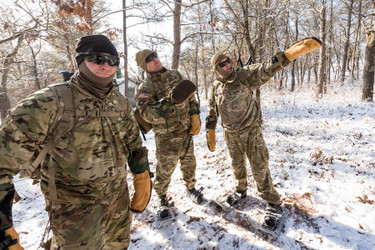Understanding Military Thermal Layers: Types and Uses
Posted by Amer Hatoum on Nov 20th 2024
Understanding Military Thermal Layers: Types and Uses
Thermal wear is essential in the military for maintaining body temperature and enhancing performance in cold-weather environments. Over the years, the military has developed and adopted various types of thermal layers, each designed to meet specific needs for warmth, moisture-wicking, and durability. Here’s an in-depth look at the most common types of military thermals, their construction, and their uses.
The Role of Thermal Layers in the Military
Military thermal layers are designed to:
- Retain body heat during cold weather operations.
- Wick moisture away from the skin to prevent chills caused by sweat.
- Provide comfort and flexibility during high-movement activities.
Types of Military Thermals
1. Polypropylene Thermals
Overview
Polypropylene is a synthetic material known for its superior moisture-wicking properties. It is lightweight, quick-drying, and effective in keeping soldiers dry during intense physical activity.
Features
- Moisture-Wicking: Moves sweat away from the body, reducing the risk of hypothermia.
- Lightweight: Ideal for layering without adding bulk.
- Durable: Resistant to wear and tear, even in harsh conditions.
Uses
Polypropylene thermals are often used as a base layer in extreme cold weather gear systems (ECWCS) for activities requiring high exertion, such as hiking or combat training.
2. Waffle Knit Thermals
Overview
Waffle knit thermals are named for their distinctive grid-like texture, which creates small air pockets for insulation. They are a favorite among military personnel for their warmth and comfort.
Features
- Enhanced Insulation: The waffle design traps air to retain heat.
- Soft Texture: Comfortable against the skin for long wear.
- Breathability: Prevents overheating while retaining warmth.
Uses
Commonly used in moderate to cold climates, waffle knit thermals are often paired with heavier outer layers for extended operations in the field.
3. Merino Wool Thermals
Overview
Merino wool is a natural material prized for its temperature-regulating properties. It is less common in military-issued gear but is often used in premium thermal products for its versatility.
Features
- Temperature Regulation: Keeps soldiers warm in cold conditions and cool in mild ones.
- Odor Resistance: Naturally antimicrobial, reducing odors during extended use.
- Comfort: Soft against the skin, unlike traditional wool.
Uses
Merino wool thermals are favored in specialty operations where comfort and long-term wearability are essential.
4. Synthetic Fleece Layers
Overview
Synthetic fleece is a popular choice for mid-layers, providing a balance of warmth and breathability. It is commonly used in combination with base layers.
Features
- High Insulation: Retains heat effectively without adding significant weight.
- Moisture Resistance: Dries quickly compared to natural fibers.
- Durable: Withstands wear in rugged environments.
Uses
Fleece layers are typically used in layered systems for extreme cold, often sandwiched between a moisture-wicking base and a waterproof shell.
How to Choose the Right Thermal Layer
- Climate Conditions
- For extreme cold: Layer polypropylene with synthetic fleece or merino wool.
- For moderate cold: Waffle knit thermals provide sufficient warmth with fewer layers.
- Activity Level
- High exertion: Use moisture-wicking layers like polypropylene to stay dry.
- Static duties: Opt for warmer layers like waffle knit or fleece.
- Durability Needs
- Choose thermals designed for rugged use, such as synthetic blends, for long-lasting performance in the field.
Modern Advancements in Military Thermals
The military continues to innovate in thermal gear by incorporating:
- Hybrid Fabrics: Combining natural and synthetic fibers for optimized performance.
- Smart Textiles: Fabrics with embedded technology for temperature regulation.
- Eco-Friendly Options: Using sustainable materials to reduce environmental impact.
Conclusion
Military thermals are a cornerstone of cold-weather operations, ensuring warmth, dryness, and comfort in the harshest conditions. From the lightweight moisture-wicking capabilities of polypropylene to the insulating power of waffle knit and fleece, each type of thermal has a specific purpose and place in a soldier's gear system. Understanding these options can help anyone—from outdoor enthusiasts to survivalists—make informed choices about layering for cold weather.
